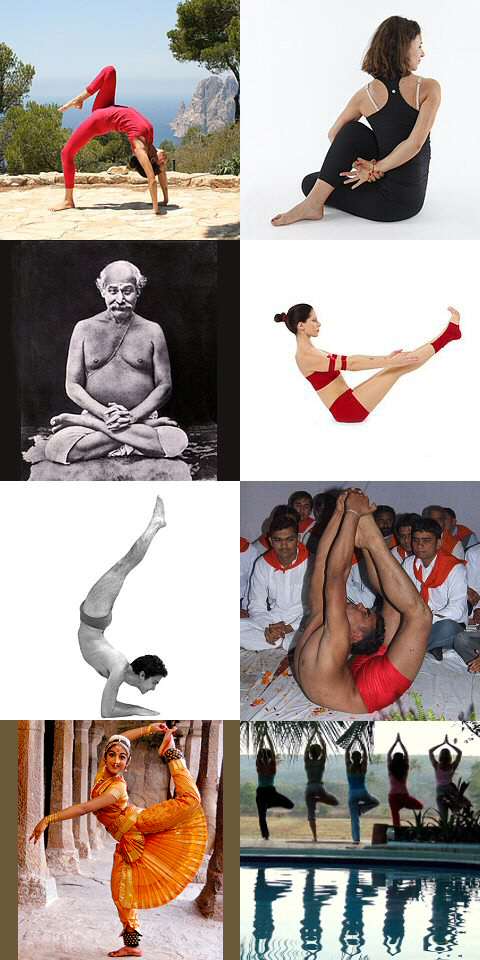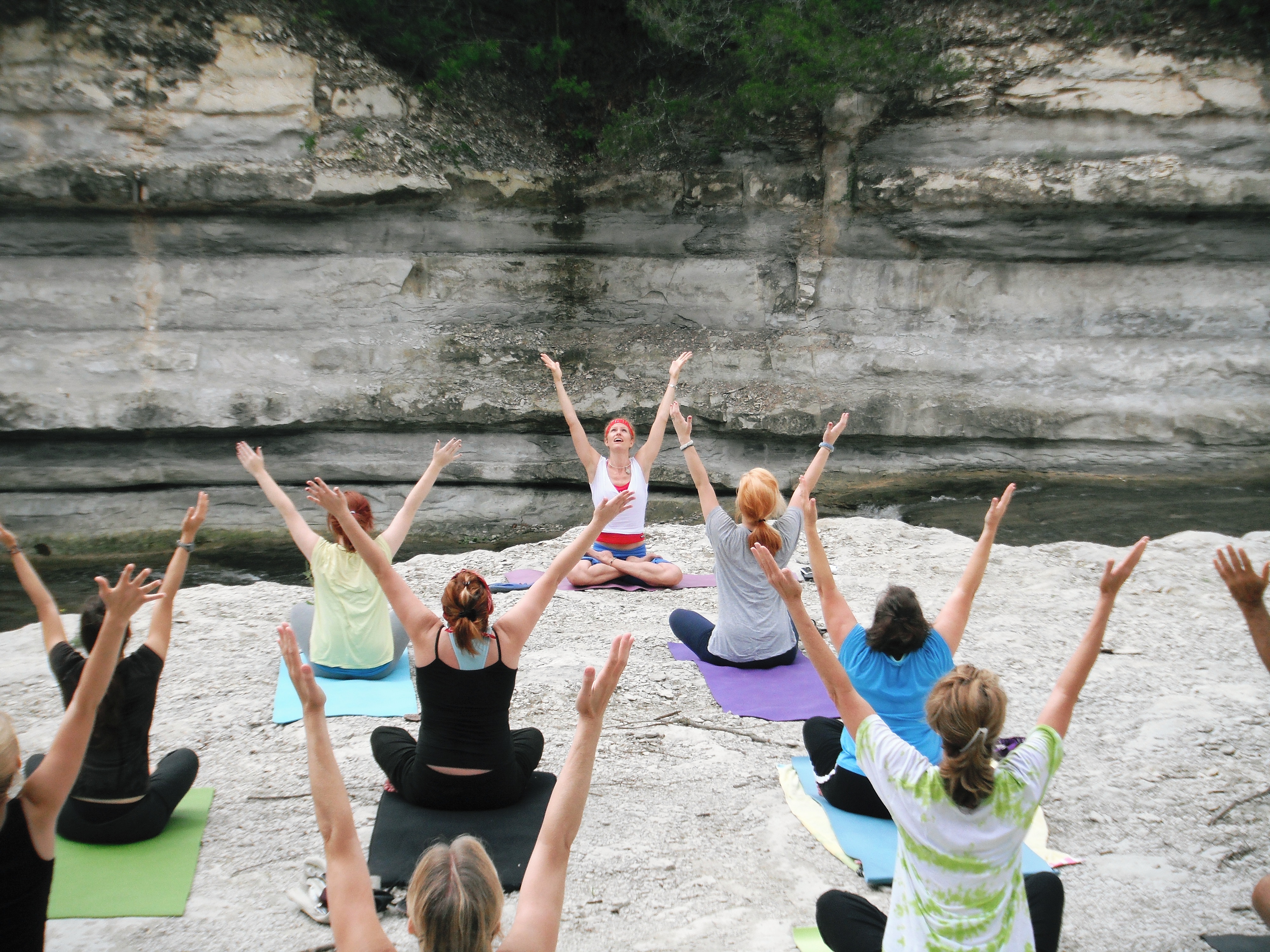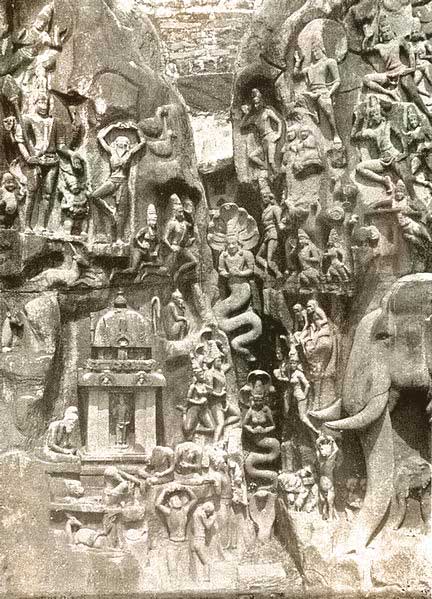|
Asanas
An āsana (Sanskrit: wikt:आसन, आसन) is a body posture, originally and still a general term for a meditation seat, sitting meditation pose,Verse 46, chapter II, "Patanjali Yoga sutras" by Swami Prabhavananda, published by the Sri Ramakrishna Math p. 111 and later extended in hatha yoga and modern yoga as exercise, to any type of position, adding reclining, standing asanas, standing, inverted, twisting, and balancing poses. The ''Yoga Sutras of Patanjali'' define "asana" as "[a position that] is steady and comfortable". Patanjali mentions the ability to sit for extended periods as one of the Ashtanga (eight limbs of yoga), eight limbs of his system.Patanjali ''Yoga Sutras of Patanjali, Yoga sutras'', Book II:29, 46 Asanas are also called yoga poses or yoga postures in English. The 10th or 11th century ''Goraksha Samhita, Goraksha Sataka'' and the 15th century ''Hatha Yoga Pradipika'' identify 84 asanas; the 17th century ''Haṭha Ratnāvalī, Hatha Ratnavali'' provid ... [...More Info...] [...Related Items...] OR: [Wikipedia] [Google] [Baidu] |
Yoga As Exercise
Yoga as exercise is a physical activity consisting mainly of asana, postures, often connected by vinyasa, flowing sequences, sometimes accompanied by pranayama, breathing exercises, and frequently ending with savasana, relaxation lying down or meditation. Yoga in this form has become familiar across the world, especially Yoga in the United States, in the US and Europe. It is derived from medieval Haṭha yoga, which made use of similar postures, but it is generally simply called "yoga". Academic research has given yoga as exercise a variety of names, including modern postural yoga and transnational anglophone yoga. Postures were not central in any of the older traditions of yoga; posture practice was revived in the 1920s by yoga gurus including Yogendra and Kuvalayananda, who emphasised its health benefits. The flowing sequences of Surya Namaskar (Salute to the Sun) were pioneered by the Rajah of Aundh State, Aundh, Bhawanrao Shrinivasrao Pant Pratinidhi, in the 1920s. It and ma ... [...More Info...] [...Related Items...] OR: [Wikipedia] [Google] [Baidu] |
Standing Asanas
The standing asanas are the yoga poses or asanas with one or both feet on the ground, and the body more or less upright. They are among the most distinctive features of modern yoga as exercise. Until the 20th century there were very few of these, the best example being Vrikshasana, Tree Pose. From the time of Krishnamacharya in Mysore, many standing poses have been created. Two major sources of these asanas have been identified: the exercise sequence Surya Namaskar (the salute to the sun); and the gymnastics widely practised in India at the time, based on the prevailing physical culture. The origin of standing asanas has been controversial since Mark Singleton (yoga scholar), Mark Singleton argued in 2010 that some forms of modern yoga represent a radical reworking of hatha yoga, in particular by adding standing asanas and transitions (vinyasas) between them, and by suppressing most non-postural aspects of yoga, rather than a smooth continuation of ancient traditions. These change ... [...More Info...] [...Related Items...] OR: [Wikipedia] [Google] [Baidu] |
Hatha Yoga
Hatha yoga (; Sanskrit हठयोग, International Alphabet of Sanskrit Transliteration, IAST: ''haṭhayoga'') is a branch of yoga that uses physical techniques to try to preserve and channel vital force or energy. The Sanskrit word हठ ''haṭha'' literally means "force", alluding to a system of physical techniques. Some hatha yoga style techniques can be traced back at least to the 1st-century CE, in texts such as the Hindu Itihasa, Sanskrit epics and Buddhism's Pali canon. The oldest dated text so far found to describe hatha yoga, the 11th-century ''Amritasiddhi, Amṛtasiddhi'', comes from a Tantra, tantric Buddhist milieu. The oldest texts to use the terminology of ''hatha'' are also Vajrayana Buddhist. Hindu hatha yoga texts appear from the 11th century onward. Some of the early hatha yoga texts (11th-13th c.) describe methods to raise and conserve bindu (vital force, that is, semen, and in women ''rajas –'' menstrual fluid). This was seen as the physical esse ... [...More Info...] [...Related Items...] OR: [Wikipedia] [Google] [Baidu] |
Iyengar Yoga
Iyengar Yoga, named after and developed by B. K. S. Iyengar, and described in his bestselling 1966 book '' Light on Yoga'', is a form of yoga as exercise that has an emphasis on detail, precision and alignment in the performance of yoga postures (asanas). The style often makes use of props, such as belts, blocks, and blankets, as aids in performing the asanas. The props enable beginning students, the elderly, or those with physical limitations to perform the asanas correctly, minimising the risk of injury or strain. History B. K. S. Iyengar learnt yoga from Tirumalai Krishnamacharya at the Mysore Palace, as did Pattabhi Jois; Iyengar Yoga and Jois's Ashtanga (vinyasa) yoga are thus branches of the same yoga lineage, sharing many of the same asanas and other practices. Iyengar began teaching yoga as exercise gradually, starting with individual pupils such as the violinist Yehudi Menuhin, whom he met in 1952; Menuhin's fame helped to propel Iyengar Yoga as a brand in the ... [...More Info...] [...Related Items...] OR: [Wikipedia] [Google] [Baidu] |
Light On Yoga
''Light on Yoga: Yoga Dipika'' (Sanskrit: योग दीपिका, "Yoga Dīpikā") is a 1966 book on the Iyengar Yoga style of modern yoga as exercise by B. K. S. Iyengar, first published in English. It describes more than 200 yoga postures or asanas, and is illustrated with some 600 monochrome photographs of Iyengar demonstrating these. The book has been described as the 'bible of modern yoga', and its presentation of the asanas has been called "unprecedented" and "encyclopedic". It has been translated into at least 23 languages and has sold over three million copies. Context Yoga is a group of physical, mental, and spiritual practices from ancient India, forming one of the six orthodox schools of Hindu philosophical traditions. In the Western world, however, yoga is often taken to mean a modern form of medieval Hatha yoga, practised mainly for exercise, consisting largely of the postures called asanas. B. K. S. Iyengar (1918-2014) was born in a poor fami ... [...More Info...] [...Related Items...] OR: [Wikipedia] [Google] [Baidu] |
Ashtanga (vinyasa) Yoga
Ashtanga yoga (not to be confused with Patanjali's ''Ashtanga (eight limbs of yoga), aṣṭāṅgayoga'', the eight limbs of yoga) is a style of yoga as exercise popularised by K. Pattabhi Jois during the twentieth century, often promoted as a dynamic form of medieval hatha yoga. Jois claimed to have learnt the system from his teacher Tirumalai Krishnamacharya. The style is energetic, synchronising breath with movements. The individual poses (asanas) are linked by flowing movements called vinyasas. Jois established his Ashtanga Yoga Research Institute in 1948. The current style of teaching is called "Mysore style", after the city in India where the practice was originally taught. Ashtanga yoga has given rise to various spinoff styles of Power Yoga, power yoga. Approach Traditionally, Ashtanga yoga students memorised a sequence of asanas and practised it together without being led by a teacher. Teacher-led classes were introduced in K. Pattabhi Jois's later years. Such classes ... [...More Info...] [...Related Items...] OR: [Wikipedia] [Google] [Baidu] |
Lotus Position
Lotus position or Padmasana () is a cross-legged sitting meditation posture, meditation pose from History of India, ancient India, in which each foot is placed on the opposite thigh. It is an ancient asana in yoga, predating hatha yoga, and is widely used for meditation in Hinduism, Hindu, Tantra, Jainism, Jain, and Buddhism, Buddhist traditions. Variations include easy pose (Sukhasana), half lotus, bound lotus, and psychic union pose. Advanced variations of several other asanas including yoga headstand have the legs in lotus or half lotus. The pose can be uncomfortable for people not used to sitting on the floor, and attempts to force the legs into position can injure the knees. Shiva, the meditating ascetic God of Hinduism, Gautama Buddha, the founder of Buddhism, and the Tirthankaras in Jainism have been depicted in the lotus position, especially in statues. The pose is emblematic both of Buddhist meditation and of yoga, and as such has found a place in Western culture as ... [...More Info...] [...Related Items...] OR: [Wikipedia] [Google] [Baidu] |
Ashtanga (eight Limbs Of Yoga)
Ashtanga yoga (, "eight limbs of yoga") is Patanjali, Pātañjali's classification of classical yoga, as set out in his ''Yoga Sutras of Patanjali, Yoga Sūtras''. He defined the eight limbs as ''Yamas, yama'' (abstinences), ''niyama'' (observances), ''Asana, āsana'' (postures), ''Pranayama, prāṇāyāma'' (breath control), ''Pratyahara, pratyāhāra'' (withdrawal of the senses), ''dhāraṇā'' (concentration), ''Dhyana in Hinduism, dhyāna'' (meditation), and ''Samadhi, samādhi'' (absorption). The eight limbs form a sequence from the outer to the inner. The posture, asana, must be steady and comfortable for a long time, in order for the yogi to practice the limbs from ''Pranayama, prāṇāyāma'' until ''Samadhi, samādhi''. The main aim is ''kaivalya'', discernment of ''Purusha, Puruṣa'', the witness-conscious, as separate from ''Prakṛti'', the cognitive apparatus, and disentanglement of ''Puruṣa'' from its muddled defilements. Definition of yoga Patanjali, Pā ... [...More Info...] [...Related Items...] OR: [Wikipedia] [Google] [Baidu] |
Haṭha Ratnāvalī
The ''Haṭha Ratnāvalī'' is a Haṭha yoga text written in the 17th century by Srinivasa. It is one of the first texts to name 84 asanas, earlier texts having claimed as many without naming them. It describes 36 asanas. Text The ''Haṭha Ratnāvalī'' is a Haṭha yoga text written in the 17th century by Srinivasa. It states (1.17-18) that asanas, breath retentions, and seals assist in Haṭha yoga. It mentions 8 purifications ( shatkarmas), criticising the ''Hatha Yoga Pradipika'' for only describing 6 of these. It is one of the earliest texts (the other being the unpublished '' Yogacintāmaṇi'') actually to name 84 asanas, earlier manuscripts having simply claimed that 84 or 8,400,000 asanas existed. The 84 asana An āsana (Sanskrit: आसन) is a body posture, originally and still a general term for a sitting meditation pose,Verse 46, chapter II, "Patanjali Yoga sutras" by Swami Prabhavananda, published by the Sri Ramakrishna Math p. 111 and late ...s lis ... [...More Info...] [...Related Items...] OR: [Wikipedia] [Google] [Baidu] |
Meditation Seat
Meditative postures or meditation seats are the body positions or asanas, usually sitting but also sometimes standing or reclining, used to facilitate meditation. Best known in the Buddhist and Hindu traditions are the lotus and kneeling positions; other options include sitting on a chair, with the spine upright. Meditation is sometimes practiced while walking, such as kinhin, doing simple repetitive tasks, as in Zen samu, or work which encourages mindfulness. Postures in the ''Yoga Sutras'' The ''Yoga Sutras of Patanjali'' describe yoga as having eight limbs, one being asana, the meditation seat. The sutras do not name any asanas, merely specifying the characteristics of a good asana, stating: The ''Sutras'' are embedded in the ''Bhasya'' commentary, which scholars including Philipp Maas now believe are by the same author; it names 12 seated meditation asanas, possibly all cross-legged, including Padmasana, Virasana, Bhadrasana (now called Baddha Konasana), and Svast ... [...More Info...] [...Related Items...] OR: [Wikipedia] [Google] [Baidu] |
Krishnamacharya
Tirumala Krishnamacharya (18 November 1888 – 28 February 1989) was an Indian yoga as exercise, yoga teacher, ayurvedic healer and scholar. He is seen as one of the most important gurus of modern yoga, and is often called "Father of Modern Yoga" for his wide influence on the development of postural yoga. Like earlier pioneers influenced by physical culture such as Yogendra and Kuvalayananda, he contributed to the revival of hatha yoga. Krishnamacharya held degrees in all the six Vedic ''darśanas'', or Indian philosophies. While under the patronage of the King of Mysore, Krishna Raja Wadiyar IV, Krishnamacharya traveled around India giving lectures and demonstrations to promote yoga, including such feats as apparently stopping his heartbeat. He is widely considered as the architect of ''vinyāsa'', in the sense of combining breathing with movement; the style of yoga he created has come to be called Viniyoga, Viniyoga or Vinyasa Krama Yoga. Underlying all of Krishnamacharya ... [...More Info...] [...Related Items...] OR: [Wikipedia] [Google] [Baidu] |







